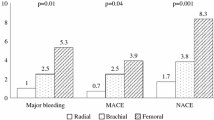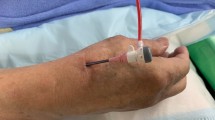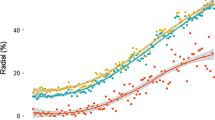Abstract
The distal radial approach (DRA) has been proposed as an alternative approach for coronary angiography (CAG) and percutaneous coronary intervention (PCI); however, the predictors of DRA failure and puncture site complications are unclear. Among 7153 consecutive patients undergoing CAG or PCI between November 2018 and January 2021, 3610 patients undergoing CAG or PCI with DRA were analyzed. The primary endpoint of this study was the procedural success, and the secondary endpoint of this study was puncture site complications during procedure. Puncture site complications during procedure were defined as a composite of major bleeding, minor bleeding, arteriovenous fistula, pseudoaneurysm, and neuropathy. The DRA success rate and the puncture site complication rate were 90.4% and 7.7%, respectively. The predictors of DRA failure were low body weight and dual antiplatelet therapy; those of DRA success were PCI and ultrasonography-guided DRA; those of puncture site complications during procedure were low body weight, peripheral arterial disease, dual antiplatelet therapy, anticoagulant therapy, and PCI; and that of no puncture site complications were previous PCI and ultrasonography-guided DRA. The negative predictors of DRA success with no puncture site complication during procedure were low body weight and dual antiplatelet therapy. The positive predictor of DRA success with no puncture site complication during procedure was ultrasonography-guided DRA. We identified the predictors of DRA failure and puncture site complications during procedure in patients undergoing CAG and PCI with DRA. Ultrasonography-guided DRA was associated with a high DRA success rate and a low puncture site complication rate in patients undergoing CAG or PCI with DRA.



Similar content being viewed by others
References
Valgimigli M, Gagnor A, Calabró P, Frigoli E, Leonardi S, Zaro T, Rubartelli P, Briguori C, Andò G, Repetto A, Limbruno U, Cortese B, Sganzerla P, Lupi A, Galli M, Colangelo S, Ierna S, Ausiello A, Presbitero P, Sardella G, Varbella F, Esposito G, Santarelli A, Tresoldi S, Nazzaro M, Zingarelli A, de Cesare N, Rigattieri S, Tosi P, Palmieri C, Brugaletta S, Rao SV, Heg D, Rothenbühler M, Vranckx P, Jüni P, Investigators MATRIX (2015) Radial versus femoral access in patients with acute coronary syndromes undergoing invasive management: a randomised multicentre trial. Lancet 385:2465–2476
Neumann FJ, Sousa-Uva M, Ahlsson A, Alfonso F, Banning AP, Benedetto U, Byrne RA, Collet JP, Falk V, Head SJ, Jüni P, Kastrati A, Koller A, Kristensen SD, Niebauer J, Richter DJ, Seferovic PM, Sibbing D, Stefanini GG, Windecker S, Yadav R, Zembala MO, ESC Scientific Document Group (2019) 2018 ESC/EACTS guidelines on myocardial revascularization. Eur Heart J 40(2):87–165
Kiemeneij F (2017) Left distal transradial access in the anatomical snuffbox for coronary angiography (ldTRA) and interventions (ldTRI). EuroIntervention 13(7):851–857
Hadjivassiliou A, Cardarelli-Leite L, Jalal S, Chung J, Liu D, Ho S, Klass D (2020) Left distal transradial access (ldTRA): a comparative assessment of conventional and distal radial artery size. Cardiovasc Interv Radiol 43(6):850–857
Lee JW, Park SW, Son JW, Ahn SG, Lee SH (2018) Real-world experience of the left distal transradial approach for coronary angiography and percutaneous coronary intervention: a prospective observational study (LeDRA). EuroIntervention 14(9):e995–e1003
Naito T, Sawaoka T, Sasaki K, Iida K, Sakuraba S, Yokohama K, Sato H, Soma M, Okamura E, Harada T, Yoshimachi F (2019) Evaluation of the diameter of the distal radial artery at the anatomical snuff box using ultrasound in Japanese patients. Cardiovasc Interv Ther 34(4):312–316
Norimatsu K, Kusumoto T, Yoshimoto K, Tsukamoto M, Kuwano T, Nishikawa H, Matsumura T, Miura SI (2019) Importance of measurement of the diameter of the distal radial artery in a distal radial approach from the anatomical snuffbox before coronary catheterization. Heart Vessels 34(10):1615–1620
Mehran R, Rao SV, Bhatt DL, Gibson CM, Caixeta A, Eikelboom J, Kaul S, Wiviott SD, Menon V, Nikolsky E, Serebruany V, Valgimigli M, Vranckx P, Taggart D, Sabik JF, Cutlip DE, Krucoff MW, Ohman EM, Steg PG, White H (2011) Standardized bleeding definitions for cardiovascular clinical trials: a consensus report from the Bleeding Academic Research Consortium. Circulation 123(23):2736–2747
Kim Y, Ahn Y, Kim I, Lee DH, Kim MC, Sim DS, Hong YJ, Kim JH, Jeong MH (2018) Feasibility of coronary angiography and percutaneous coronary intervention via left snuffbox approach. Korean Circ J 48(12):1120–1130
Kashiwagi M, Tanimoto T, Kitabata H, Arita Y, Yamamoto Y, Mori K, Terada K, Nishiguchi T, Taruya A, Kubo T, Tanaka A, Akasaka T (2019) Usefulness of rescue ultrasound guidance for transradial cardiac catheterization. Cardiovasc Revasc Med 20(4):311–315
Dehghani P, Mohammad A, Bajaj R, Hong T, Suen CM, Sharieff W, Chisholm RJ, Kutryk MJ, Fam NP, Cheema AN (2009) Mechanism and predictors of failed transradial approach for percutaneous coronary interventions. JACC Cardiovasc Interv 2(11):1057–1064
Nakamura M, Kadota K, Nakao K, Nakagawa Y, Shite J, Yokoi H, Kozuma K, Tanabe K, Iijima R, Harada A, Kuroda T, Murakami Y (2021) High bleeding risk and clinical outcomes in East Asian patients undergoing percutaneous coronary intervention: the PENDULUM registry. EuroIntervention 16:1154–1162
Yoshioka N, Takagi K, Morita Y, Kanzaki Y, Nagai H, Watanabe N, Morishima I (2021) Bleeding events and mid-term mortality in the patients undergoing endovascular interventions for peripheral artery disease of the lower limbs based on the academic research consortium high bleeding risk criteria. Heart Vessels 36(9):1336–1349
Yoshimachi F, Ikari Y (2021) Distal radial approach: a review on achieving a high success rate. Cardiovasc Interv Ther 36(1):30–38
Akioka H, Yufu K, Harada T, Akamine K, Uemura T, Takahashi M, Nishimizu K, Hirota K, Ishii Y, Kira S, Yonezu K, Abe I, Tawara K, Kondo H, Saito S, Fukui A, Okada N, Shinohara T, Teshima Y, Nakagawa M, Takahashi N (2022) Reduction of bleeding complications on puncture site after percutaneous coronary intervention using a 6.5-French sheathless guiding catheter. Heart Vessels 37(6):954–960
Honda T, Fujimoto K, Miyao Y, Koga H, Hirata Y (2012) Access site-related complications after transradial catheterization can be reduced with smaller sheath size and statins. Cardiovasc Interv Ther 27(3):174–180
Natsuaki M, Morimoto T, Shiomi H, Ehara N, Taniguchi R, Tamura T, Tada T, Suwa S, Kaneda K, Watanabe H, Tazaki J, Watanabe S, Yamamoto E, Saito N, Fuki M, Takeda T, Eizawa H, Shinoda E, Mabuchi H, Shirotani M, Uegaito T, Matsuda M, Takahashi M, Inoko M, Tamura T, Ishii K, Onodera T, Sakamoto H, Aoyama T, Sato Y, Ando K, Furukawa Y, Nakagawa Y, Kadota K, Kimura T, CREDO-Kyoto PCI/CABG Registry Cohort-3 Investigators (2021) Application of the modified high bleeding risk criteria for Japanese patients in an all-comers registry of percutaneous coronary intervention—from the CREDO-Kyoto Registry Cohort-3. Circ J. 85(6):769–781
Mori S, Hirano K, Yamawaki M, Kobayashi N, Sakamoto Y, Tsutsumi M, Honda Y, Makino K, Shirai S, Ito Y (2020) A comparative analysis between ultrasound-guided and conventional distal transradial access for coronary angiography and intervention. J Interv Cardiol 2020:7342732
Sgueglia GA, Lee BK, Cho BR, Babunashvili A, Lee JB, Lee JW, Schenke K, Lee SY, Harb S (2021) Distal radial access: consensus report of the first Korea-Europe transradial intervention meeting. JACC Cardiovasc Interv 14(8):892–906
Quan Z, Tian M, Chi P, Cao Y, Li X, Peng K (2014) Modified short-axis out-of-plane ultrasound versus conventional long-axis in-plane ultrasound to guide radial artery cannulation: a randomized controlled trial. Anesth Analg 119(1):163–169
Hadjivassiliou A, Kiemeneij F, Nathan S, Klass D (2021) Ultrasound-guided access of the distal radial artery at the anatomical snuffbox for catheter-based vascular interventions: a technical guide. EuroIntervention 16(16):1342–1348
Kurisu K, Osanai T, Kazumata K, Nakayama N, Abumiya T, Shichinohe H, Shimoda Y, Houkin K (2016) Ultrasound-guided femoral artery access for minimally invasive neuro-intervention and risk factors for access site hematoma. Neurol Med Chir 56(12):745–752
Acknowledgements
The authors are grateful to the staff members of the cardiac catheterization laboratory, and Miho Kobayashi, and Makiko Kanaike, for their assistance with the manuscript. The authors also thank Hayato Shimizu and his colleagues for technical assistance.
Author information
Authors and Affiliations
Corresponding author
Ethics declarations
Conflict of interest
All authors have no relationships relevant to the contents of this paper to disclose.
Additional information
Publisher's Note
Springer Nature remains neutral with regard to jurisdictional claims in published maps and institutional affiliations.
Rights and permissions
Springer Nature or its licensor holds exclusive rights to this article under a publishing agreement with the author(s) or other rightsholder(s); author self-archiving of the accepted manuscript version of this article is solely governed by the terms of such publishing agreement and applicable law.
About this article
Cite this article
Ikuta, A., Kubo, S., Osakada, K. et al. Predictors of success and puncture site complications in the distal radial approach. Heart Vessels 38, 147–156 (2023). https://doi.org/10.1007/s00380-022-02152-6
Received:
Accepted:
Published:
Issue Date:
DOI: https://doi.org/10.1007/s00380-022-02152-6




